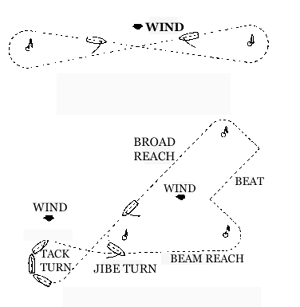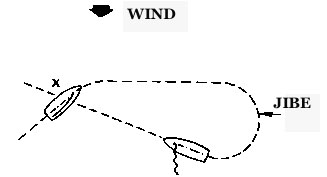| If you started off across the
river or lake on a reach as we suggested for you initial sail,
you will eventually reach a point where you must turn and head
back. If the turn changes the wind from one side of the boat
to the other, you will have tacked or jibed.It will be a TACK
(also called coming about) if you turn the bow of the boat through
the eye of the wind, and it will be a JIBE if you turn the stern
through the eye of the wind. |
 |
Since the sail reacts quite differently
to the two types of turns, it is of the utmost importance that
you know which maneuver you are performing. |
In a small boat such as the Tech
Dinghy, the tack is a safer maneuver so you should start with the
tack rather than the jibe. The closest angle you can expect to sail
toward the wind is a 45° angle, so to perform a tack you must turn
a minimum of 90° to complete the tack.If you are going from a beam
reach in one direction to a beam reach in the opposite direction,
a 180° turn will be required. Since the sail will be luffing during
most of the tack it is important the boat have good speed (relative
to the given wind speed) through the water.If the sail is well out
or luffing, trim the boom into the back corner of the hull if you
can do so without causing excessive tipping to leeward. Ideally
the sail should be trimmed as the turn into the tack is started,
however, during the learning process it would be permissible to
trim in first. Ease the tiller to leeward to start the tack, but
keep your body weight to windward initially to avoid throwing the
boat out of balance.
Watch the sail and when the boom starts toward you, duck under the
boom and move toward the new windward side by standing momentarily
and pivoting around facing the bow (it is important to be able to
watch the luff of the sail and see just where your bow is pointing).
Bring your hand holding the SHEET (the rope which controls the sail)
behind your back to collect the tiller, letting the sheet slide
through your hand and maintaining only enough pressure on the line
to keep it from running out. Do not straighten the tiller until
the sail stops luffing or until the boat swings further to some
point you now wish to head for. Straightening the tiller before
the sail stops luffing will leave the boat stuck IN IRONS (stopped
headed into the wind). Failure to straighten the tiller after the
tack will cause the boat to keep turning until it jibes. After
the tack, adjust your weight for good boat trim and take the sheet
in the forward hand, and adjust the sail to assure it is properly
trimmed for the course you have selected (so it is just on the verge
of luffing). Jibing is the opposite of tacking, and as we said earlier,
involves a turn that moves the stern through the eye of the wind.
Unlike the tack, the sail will cross quickly to the new side without
any luffing, and in a strong wind this sudden change of wind pressure
from one side of the boat to the other can cause a capsize if precautions
are not taken.
| Also, unlike the tack, a large change
of course is not necessary for a jibe to occur. If the boat
is already sailing on a RUN (a course where the wind is at the
stern) a change of course of a few degrees Ð or a wind shift
of a few degrees, can cause a jibe. |
 |
To perform a controlled jibe, move the tiller to windward (away
from the sail) and immediately reach around behind your back with
the forward hand to hold the tiller to windward. At the same time
move your weight to the centerline of the boat again facing toward
the bow. The maneuver of moving your weight can be done with you
in a deep knee squat, thus keeping your head low and out of the
way of the boom. As you become more confident, you can stand and
duck at the appropriate time and be in a better position to move
your weight to keep the boat level. In a larger, more stable boat
you would trim the sail all the way in and ease it out again on
the new leeward side to cushion the shock of the boom snapping from
one side to the other.
In a boat as small as the Tech, trimming the sail more than
half way in may cause excessive tipping to leeward, however, it
is desirable to trim the sail half way in so the wind can get behind
the leech of the sail and force the sail across without your having
to sail too much BY-THE-LEE (where the wind is striking the leeward
side of the boat). You should watch the telltale on the stay to
see when you are by-the-lee and watch the leech of the sail since
it will fold toward you just before the boom is blown across. If
it is quite windy, get the tiller back to the centerline of the
boat as soon as you see the sail start to move across so you will
not end your jibe on a beam reach and consequently be tipped excessively
to leeward. Also ease out the sail as soon as it crosses the boat
to prevent tipping. After the jibe, adjust your weight for good
boat trim and also check your sail for proper trim.
|



